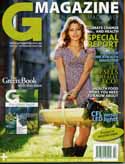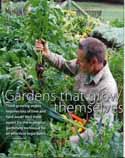Hooray! Edible Gardening for the clueless.
Confession time, gardeners and backyard farmers. I have never successfully grown an edible plant. To call me a “newbie gardener” is too kind. I am a plant serial-killer. The closest I can claim is the summer I got 1 or 2 tomatoes from a medium sized patch before the last plant died.
So the more I’ve read about organic gardening, the more worried I get. Can I really pull this off? This is a LOT of work. I also have a full-time job, two little kids, and permanent mommy-brain. But I do love to dig in the dirt. And eat. I love to eat.
One obstacle was sorting through the REAMS of conflicting information out there. Till or no-till? Should lasagna mulch have 4 layers or 6? What veggies do I want to grow, and what companion plants belong with them? How do I design a forest guild if I don’t know what tree I want to start with? How can I find time to do a complete site and zone survey? It’s the middle of April — I’ve got to get seeds in the ground ASAP if I want to eat it this year!
WHY CAN’T SOMEONE JUST TELL ME EXACTLY WHAT TO PLANT? JUST DRAW ME A FRIGGIN’ PICTURE!
God bless Jonathan White… he did just that.
 Jonathan created a program for edible gardeners called Food 4 Wealth. To me, this E-book and video collection is a Godsend.
Jonathan created a program for edible gardeners called Food 4 Wealth. To me, this E-book and video collection is a Godsend.
Jonathan is what they call in Australia, an “ecological gardener” with 20 years experience, and he’s drawn the whole thing up for me. It’s a brief, clearly-written, 98-page E-book (not an encyclopedia) that tells you everything you need to know to plant a self-perpetuating, companion-planted, no-till raised bed vegetable garden. He tells you why it works, but you don’t have to understand everything to use it.
Along with the main book, there is a project plan with all the measurements and supply lists done for you. The plants chosen have varietals that grow in practically any climate. There are visual layouts and checklists, so you can follow step-by-step. You can see where to put paths, where to place each plant (relative to each other, and relative to north/south directions).
On top of that, there are directions for growing fruit in a miniature food forest, with layers of plants benefiting each other.
Jonathan’s approach cuts the planning and grunt-work to a fraction. Once you set up the system, Nature does most of the work for you, year after year. I like that. I think Nature has a better track record on this than I do.
Now, I am a total cheapskate. I hate shelling out a dime for anything I can find for a penny. The first time I encountered a description of Food 4 Wealth, I noticed it cost about as much as two hardback novels. I thought, “Forget it! I can learn this for free on the Internet or at the library.”
No, actually, I couldn’t.
Sure, some of the concepts are well-known. After all, plants have been growing the same way for millennia. What makes Food 4 Wealth worth so much more than the asking price is the way Jonathan has designed and planned everything, and made it so useable.
How long would it take for me to learn, experiment and come up with a proven, streamlined system like this? How much money would I spend on seeds and tools that wouldn’t produce one edible result? “How many licks does it take to get to the tootsie-roll center of a tootsie pop?” It just ain’t gonna happen.
I want to be fair, so I was trying to think of some cons to the system. Here’s what I came up with:
- This system will not grow a complete diet. It’s not advertised to — that’s just on my personal wish list. It is meant to replace a large portion of your fresh produce (and grow enough to share or sell), not to make you totally self-sufficient.
- Jonathan does encourage experimenting with other plants, but the information about going off the plan is limited. For example, if you substitute one plant for another, how does that affect the companion planting scheme? Not much detail on that, but of course I like the book because it is not drowning in too much detail. That’s a tradeoff.
- Some of the terms, like “punnet” and “lucerne”, are not in Americanese and need translating.
Honestly, that’s all I could come up with. I haven’t watched the videos yet. I’ll be back to talk about them when I do. I am so thrilled with what I have in my hands. I can do this! And as I do, you can see for yourself how it works.
You can find out more about Food 4 Wealth and watch Jonathan in action HERE!
Jonathan’s gardening system has been featured in G Magazine:

